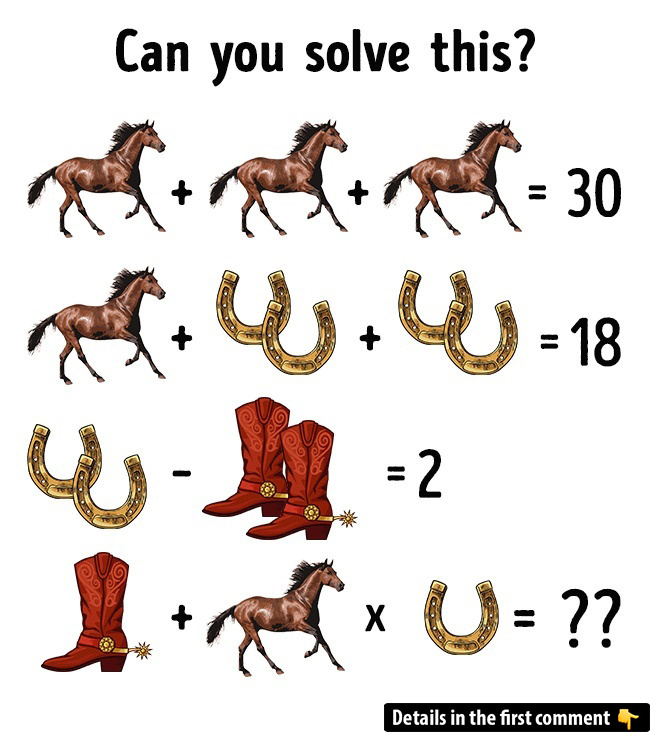Can You Solve This Horse Puzzle? The Answer Lies in the Details – See the Full Explanation!

At first glance, this riddle looks like an easy win. It involves horses, horseshoes, and boots—each representing a number. Your job is to figure out the value of each symbol and solve the final equation. But here’s the catch: almost everyone makes the same mistake, and the real answer is not what most people expect.
Let’s walk through the entire puzzle, step by step, and see why the correct answer is 21, not 41 or anything else. The key lies in the details—so read carefully.
The Puzzle Setup
There are three picture-based equations to solve before the final question. Each line includes symbols: a horse, a pair of horseshoes, and a pair of boots. Your task is to decode the value of each symbol and then plug those values into the last equation.
Video: Take a breather and enjoy the charm of these light-hearted challenges!
Step 1: Assigning Values to Each Symbol
Let’s label the items for clarity:
Horse = X
Horseshoe = Y
Boot = Z
Now, we solve the equations.
Equation 1: Horse + Horse + Horse = 30
3X = 30
Divide both sides by 3:
X = 10

Equation 2: Horse + Horseshoe + Horseshoe = 18
We already know Horse = 10
So:
10 + 2Y = 18
2Y = 8
Y = 4
Equation 3: Horseshoe – (Boot + Boot) = 2
We know Y = 4
4 – 2Z = 2
-2Z = -2
Z = 1
So now we have:
Horse = 10
Horseshoe = 4
Boot = 1
Seems easy enough, right? But here’s where people slip up.
The Final Equation: Boot + Horse × Horseshoe = ?
Here’s what most people do: 1 + 10 × 4 = 1 + 40 = 41
That’s the wrong answer. Why?
Because they didn’t look closely at the symbols in the final line.
Where Most People Go Wrong
In the earlier equations, the horseshoe symbol represents a pair of horseshoes, not one. So the value of Y = 4 means each horseshoe is worth 2.
Same with the boots—they appear as a pair in the third equation, meaning each individual boot equals 1.
So let’s re-analyze the final line based on what’s actually shown:
There is one boot = 1
One horse = 10
One horseshoe = 2 (because 4 was the value of a pair)
Final Equation Revisited: 1 (boot) + 10 (horse) × 2 (horseshoe)
Using correct order of operations: 10 × 2 = 20
1 + 20 = 21
Why the Right Answer Is 21

This isn’t just a math problem—it’s a visual logic test. Most people miss the detail that horseshoes and boots were originally shown in pairs. But in the final line, there’s only one of each. That changes the math entirely.
What makes this riddle so clever is how it uses symbols to subtly shift meaning. The numbers don’t change—but the quantity of each item does. And if you don’t look closely, you’re bound to fall into the trap.
Takeaways from the Puzzle
Video: Can You Solve The Four 9s Puzzle?
This puzzle reminds us how important it is to slow down, observe, and question our first instincts. It’s not about complex math—it’s about visual awareness and logical thinking. Always look at the fine details before you jump to conclusions.
Did you answer 21? If so, great job—you caught the trick most people missed. If not, now you know what to look for next time. Share this riddle with your friends and see how many catch the hidden twist.
The Cognitive Benefits of Quizzes for the Human Brain
Quizzes are often associated with classrooms and game shows, but their benefits extend far beyond entertainment or academic assessment. They are powerful tools that can enhance brain function, improve memory, and promote lifelong learning. Recent research in cognitive psychology and neuroscience highlights the positive effects of quizzing on brain health and intellectual development.
One of the most significant benefits of quizzes is the testing effect. This phenomenon suggests that retrieving information from memory, as one does during a quiz, strengthens that memory more than simply re-studying the information. When individuals actively recall facts or concepts, neural connections associated with that knowledge become more robust. This improves long-term retention and makes it easier to retrieve the information in the future. In short, quizzing reinforces learning in a way that passive review does not.
Quizzes also encourage active learning. Unlike reading or listening, taking a quiz requires the learner to engage with the material, think critically, and apply knowledge. This active engagement helps the brain encode information more deeply. As a result, learners are more likely to understand and remember the content, rather than merely memorize it.
Additionally, quizzes enhance metacognition, or the awareness of one’s own knowledge and thought processes. When individuals take a quiz, they receive feedback—either immediately or afterward—that helps them evaluate what they know and what they still need to learn. This process fosters self-awareness and helps learners adjust their study strategies for more effective outcomes. Knowing which areas are weak or strong allows for targeted practice, which is crucial for skill development.
Regular quizzing can also improve attention and focus. When people expect to be tested, they are more likely to concentrate during the learning phase. This heightened attention boosts the quality of learning and helps prevent the common problem of mind-wandering. Over time, the habit of focusing in preparation for quizzes can lead to improved concentration in other areas of life as well.
Beyond the cognitive benefits, quizzes also provide emotional and motivational advantages. They offer a sense of achievement, especially when learners see progress over time. This can increase motivation, reduce anxiety around testing, and build confidence in one’s abilities. Quizzes with gamified elements, such as points or levels, can also make learning more enjoyable and engaging.
From a neurological perspective, the brain thrives on challenge and novelty—two key features of well-designed quizzes. They stimulate the brain’s reward system by offering immediate feedback and small successes, keeping the learner mentally engaged. Furthermore, regular mental challenges such as quizzes are associated with a reduced risk of cognitive decline as people age, suggesting they may even contribute to brain health over the long term.
In conclusion, quizzes are far more than academic exercises. They are dynamic cognitive tools that reinforce memory, encourage active engagement, sharpen focus, and promote self-awareness. Whether used in schools, professional training, or self-study, quizzes play a vital role in enhancing learning and maintaining a healthy, active brain.
